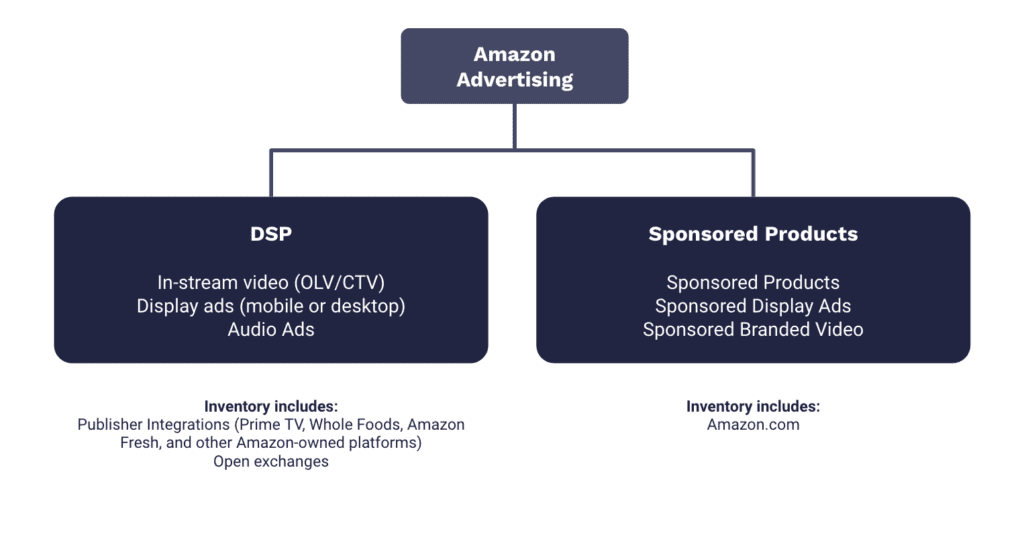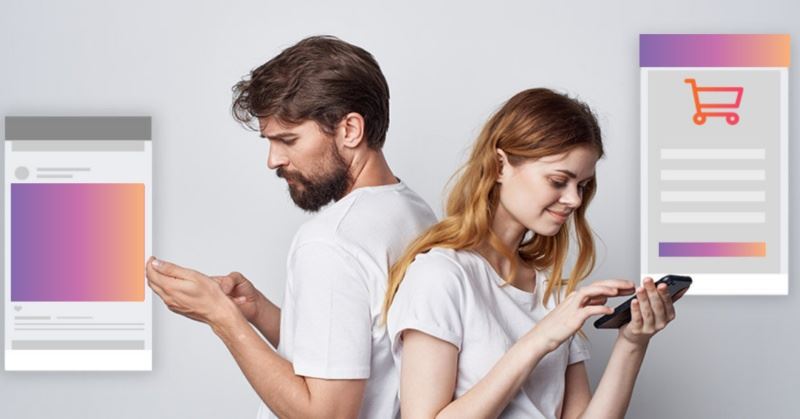The devil might wear Prada—but we bet she buys it on Amazon.
In the last two years, e-commerce has surged into popularity with more and more companies and consumers moving online for their shopping needs. The online retail space saw a rise of almost 25 percent in 2020 alone—with approximately 1 out of every 2 consumers beginning their shopping journey on an Amazon-related platform. With this valuable growth in the virtual consumer market making Amazon advertising more appealing, we wanted to highlight some tips to know when taking the plunge into Amazon DSP advertising, allowing you to reach consumers where they are shopping.

1) Amazon DSP is not the same as Amazon Sponsored Products
It is important to note that Amazon DSP is a completely different beast than Amazon’s Sponsored Products, which also includes display advertising. Sponsored Display is a self-servicing PPC advertising product, meaning the brand must be selling products on Amazon to run sponsored display ads. This comes with limitations. For instance, if a product sells out, then the ads will stop serving, and these ads will only be served on Amazon. The Sponsored Display ads function mainly in the mid-to-lower funnel, focused on driving purchases on Amazon.
The DSP can function as a supplement of Sponsored Display by providing more upper-funnel awareness and reach to test different creatives, audiences, and frequencies while meeting consumers off Amazon in typical inventory available to any other DSP. The bonus is that Amazon’s data can be applied for targeting, which can allow you to provide more seamless retargeting strategies across campaigns.
Hot tip: If advertising through both, the accounts can be linked in order to deduplicate conversions between sponsored display and DSP to receive more accurate attribution reporting.
2) It’s not only meant for brands on Amazon
The Amazon DSP offers the ability to advertise through Amazon’s premium publisher sites & exchange inventory without being an Amazon seller. This option allows for almost any brand to use the DSP to programmatically buy ads with access to Amazon’s exclusive targeting. Amazon offers remarketing and conversion tagging that can be placed on a brand’s website, allowing for easy tracking of purchase results and retargeting efforts to drive consumers further down the funnel. These options allow the Amazon DSP to be considered like other programmatic platforms to serve ads—rather than just Amazon-specific ad serving—with the addition of the benefits of Amazon’s exclusive audience targeting.
3) Serves across many platforms other than amazon
The Amazon DSP offers the ability to serve across Amazon publisher sites such as Prime TV, Whole Foods, Amazon Fresh as well as Amazon-owned platforms including IMDb, Audible, Box Office Mojos, Goodreads, Zappos, Twitch, and many more. These off-Amazon programmatic buying opportunities offer a broad variety of consumer reach and targeting. The Amazon DSP allows brands to go beyond Amazon alone, creating a more full-funnel approach. In addition to a variety of online platforms, Amazon also offers the ability to gain offline sales data from Whole Foods. This integration of offline data creates a complete picture of the consumer purchase cycle and helps establish a more comprehensive ROAS, since it incorporates both in-store and online activity.
4) Being one of the top e-commerce platforms comes with its perks: Audience Insights
With over half of the country’s consumers beginning their consumer journey searching on Amazon, one of the main benefits of the Amazon DSP is the ability to utilize Amazon’s extensive first-party audience data. Amazon’s massive scale as an e-commerce company allows them the ability to know what consumers are shopping for and where—making their audience targeting a golden ticket for many advertisers. Contradictory to other platforms, rather than showing only where consumers are buying, Amazon can show what consumers are buying.
All of this data is great, but you might be asking the question, “What if I don’t know which audiences to target?” Amazon offers additional Shopper Audience Discovery tools that compare your brand’s behaviors with that of other category interests to help give insights into what other areas could be beneficial to target. In addition to a wide variety of audiences, Amazon also gives insights into New-to-Brand consumers. These insights can be useful to help determine consumers that have not shopped with the brand before and guide the brand towards potential retargeting efforts.
5) Full-funnel Advertising Platform
The Amazon DSP offers a full-funnel approach to advertising with its ability to programmatically buy on and off Amazon-owned sites. With their extensive audience reach and the ability to buy on Amazon-owned sites, such as IMDB and Twitch, the Amazon DSP catches consumers at every part of the funnel. By meeting the consumers where they are, Amazon DSP can guide consumers back to a brand’s product while encouraging them to convert.
Amazon DSP also offers advertising across a wide variety of channels, including native, display, OLV, OTT, which aids in broadening the scope of creating brand awareness and reaching new consumers.
Amazon’s impressive audience data plays a huge role in the purchase stage of the funnel. The ability to now see which consumers are interacting and purchasing with a brand’s products, its competitor’s products, or similar products helps determine a streamlined retargeting strategy to lead the consumers to purchase intent. Amazon’s remarketing strategy also assists in keeping consumers coming back with insights into new-to-brand consumers as well as repeat consumers helping to establish brand loyalty.
6) Plan accordingly: Amazon does not allow for third party tracking
One important caveat to executing campaigns in Amazon’s DSP, is that it does not allow for third-party tracking. The good news, however, is that since the Amazon DSP offers a broad range of channels to serve ads, it is possible to execute a cross-channel programmatic buy without needing third-party services. This means that Amazon will have to be used as the source of truth for campaign performance.
7) It’s not as intimidating to get started as you might think
Getting started with the Amazon DSP is not as intimidating as it might sound. Since the Amazon DSP can be a tool for brands that do not necessarily sell on Amazon, the setup can be quite simple. A brand does not even need a website to get started—simply an Amazon portfolio will do. Brands can leverage the full capabilities of Amazon’s platform in order to create a high-end campaign without getting too granular while receiving profitable results in return.
Ready to get started on Amazon, or want to talk about Amazon strategy? We’re here for you! Drop us a note and we can help craft a best-in-class Amazon strategy for your business.


